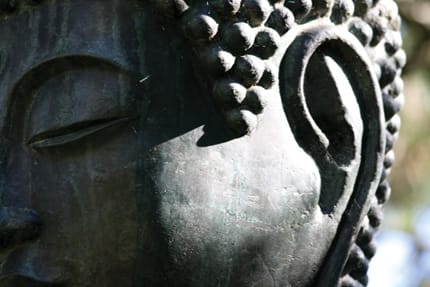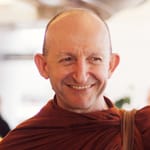One practice that can help free the heart from the compulsions of self-view is to meditate upon your own name. Begin by taking a moment to listen to the inner sound. Focus on that until the mind is clear and open and then simply voice your own name internally. Listen to the sound of silence before your name, then to the sound of silence within and then behind your name, and finally to the sound of silence after you repeat it: “A-ma-ro,” “Su-san,” “John.” See and feel what qualities that sound brings. It’s only the sound of your own name, something so familiar, so ordinary. See what happens when it’s dropped into the silence of the mind and really felt and known for a change. Notice what quality it brings, how it opens up the habit of seeing ourselves in a particular way, how it loosens the boundaries.
To our surprise, that name, those familiar syllables, can suddenly feel like the most peculiar, weird formulation in the world. Something in the heart stirs and intuits, “What’s that got to do with anything real?” In that moment we realize that what the word forming our name is usually taken to refer to, the me, is actually a quality that is utterly non-personal.
Voicing our name in the clear open space of wisdom like this can feel like trying to write it with a light beam on a waterfall. There is nothing to make a mark with and no surface that will provide traction. This kind of practice can be both slightly disturbing and gloriously freeing, and if we do allow it to free us, all that remains is that taste of freedom and the sound of the rushing waterfall.
Another perhaps even more direct way we can work with listening is to use a form of questioning to approach and dissolve habits of self-view.
Again, listen to the sound of silence; focus on it to steady the attention. Let the mind be as silent and alert as possible, and then raise the question, “Who am I?” Notice what happens when that question is sincerely asked. We’re explicitly not looking for a verbal answer, a conceptual answer. Notice that there’s a brief gap after we pose the question and before any conceptual answers appear. When we really ask that question, “Who am I?” or “What am I?” there’s a gap, a space that opens up for a moment in which the heart is open to doubt about the presumptions we’ve made about being a person—being a woman, a man, old, young. There’s a moment of “Oh!” before all the personal details start wading in. There’s a gap, a hesitation. “Who am I?”
Let your attention rest in that gap after the end of the question and before the answers appear. Just rest in that gap, in that spaciousness, because in the truest sense, the silence of the mind is the answer to the question. Allow and encourage the mind to rest in that open, attentive, unconstructed spaciousness, because in that moment self-view is interrupted. The normal self- creating habits are confused. The self-creating habit is caught in the act. Suddenly the camera is turned back onto the photographer before they can scurry away. It’s the unconstructed, unconditioned moment. There’s attention—the mind is alert, peaceful, and bright—but there’s no sense of self. It’s extraordinarily simple and natural. Let the attention rest with that.
After a while, when other more habitual concerns drift back in—an ache in the leg, the sound of a passing car, a tickle in the nose— and the self-views re-coalesce, then focus the mind attentively; come back to the nada-sound, listen, and raise the question again—“Who am I?”—to open up that same window of curiosity and reality. Allow it to puncture the bubble of self-view for just a moment. Notice what it’s like when that bubble no longer colors and distorts our vision of things and self-view falls away. What’s here? What is life like when that habit is interrupted?
As with the meditation on your name, this practice can be simultaneously threatening and relieving, but if we can be undistracted by either of those feelings and simply remain alert and open to the present, what is realized is the presence of purity, radiance, and peacefulness, all held in the embrace of the roaring silence.
From Inner Listening, published by Amaravati Publications, 2012. Reprinted with permission.

